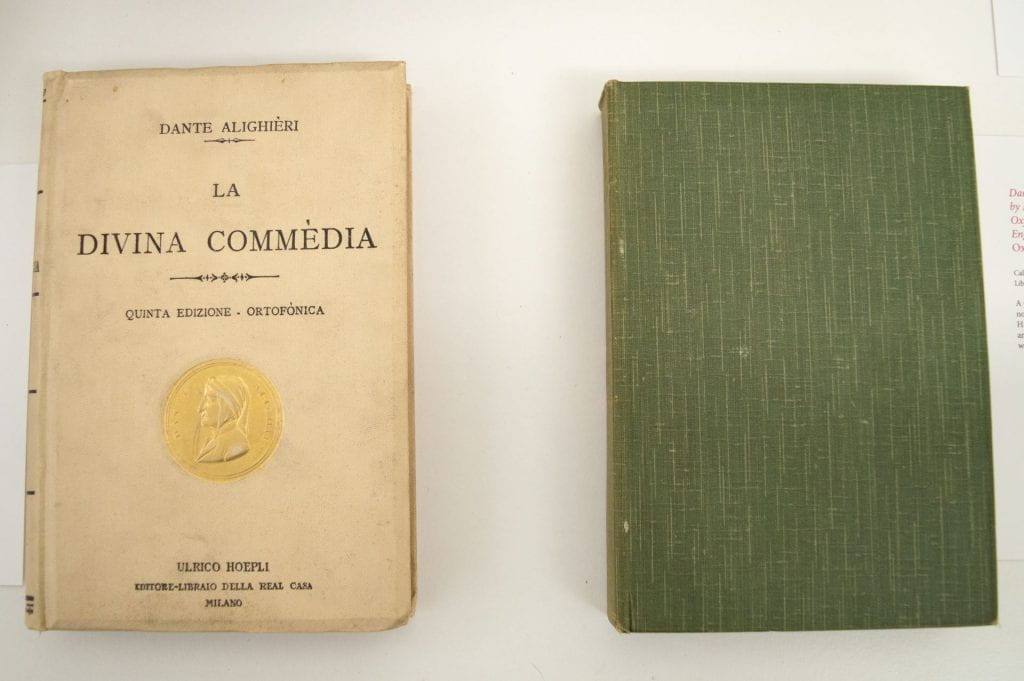La divina commèdia di Dante Alighièri: corredata dei segni della pronunzia e di nuòvi spediènti utili all’evidènza, ai raffronti, alle ricerche, alla memorazione dal Prof. Luigi Polacco. Quinta edizione dallo stesso riveduta e arricchita di una tavola delle parti e di alcune osservazioni sulla pronunzia delle consonanti. Milano: Ulrico Hoepli, 1913.
Call number: PQ 4302 .F13 (Special Collections)
Case 1: “The Divine Comedy Between Texts and Images”
[Translation of the title in English: “Dante Alighieri’s Divine Comedy, accompanied by signs of pronunciation and new means useful for evidence, comparisons, research, and memorization by Prof. Luigi Polacco. Fifth edition revised by the same author and enriched with a table of contents and some observations on the pronunciation of consonants”]
This edition of the Divine Comedy conceives of the pronunciation of vowels in accordance with orthoepic rules. Ideas on how to reform the graphic system of the Italian language started with Gian Giorgio Trissino (1478-1550), who proposed a Florentine graphic and phonetic reform during the sixteenth-century “questione della lingua” (discussion on which language to adopt when writing literature). He added signs to the Italian alphabet in order to express its phonetic rules more precisely. Specifically, Trissino suggested the use of the Greek letter omega /ω/ to indicate the close vowel /o/ and the use of the Greek letter epsilon /ε/ to indicate the open vowel /e/, along with other symbols to express voiceless and voiced consonants, such as /z/ and /s/. He adopted these symbols in his 1529 edition of De Vulgari Eloquentia, a work by Dante that had been doomed to oblivion before Trissino’s publication, and in his Pωεtica and Rime published in 1529. Despite these efforts, Trissino did not succeed in establishing his graphic reform widely.
In the exhibited edition of the Divine Comedy, Polacco specifies where the accent falls on the words. He uses an acute accent for the close vowels /e/ and /o/, a grave accent for the open vowels /e/ and /o/, a period on top of the voiced consonants /s/ and /z/, and no sign for the voiceless consonants /s/ and /z/. Like Trissino, Polacco emphasizes Florentine speakers’ awareness of the phonetic openness and closure of the vowels /e/ and /o/. Accordingly, he thinks that the phonetic rules of the Florentine vernacular should be adopted in writing. The marks that Polacco includes are intended to facilitate the pronunciation of Italian for the express purpose of better recitating Dante’s text, given that “la Divina commedia non va soltanto letta silenziosamente; essa va altresi letta ad alta voce, studiata e recitata a memoria, citata nelle conversazioni e nei discorsi” [“the Divine Comedy should not only be read silently; it should also be read aloud, studied and recited by memory, and cited in conversations and speeches”].
This edition consists of observations on the signs used in the text, considerations on the pronunciation of vowels, a list of works and dictionaries dedicated to orthoepy as well as the correct pronunciation of Italian, a detailed description of the pronunciation of consonants, and an overview of phonetic rules prescribing the use of consonants and clusters of consonants. After the text of the three canticles introduced by a list of the characters and the main events occurring in each canto, a table with all the parts that constitute Inferno, Purgatorio, and Paradiso concludes the book.

